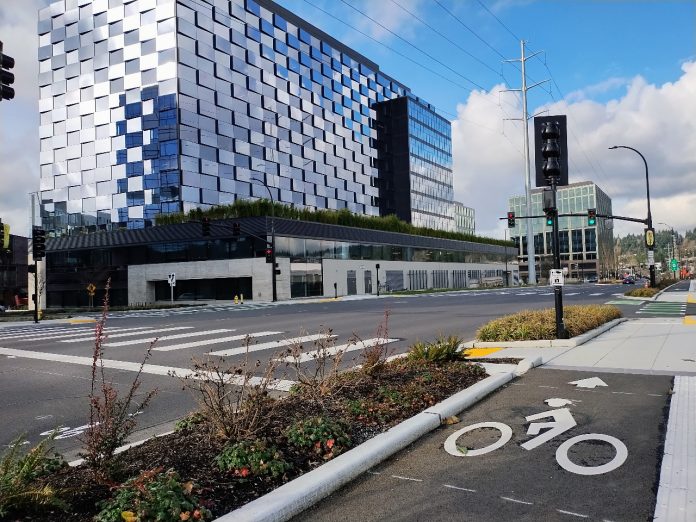
With Bike Bellevue scaled back, BelRed’s only proposed east-west route — Spring Boulevard — is on track to be completed sometime next decade.
The City of Bellevue is going after a grant to fund design work on a brand new half-mile stretch of street near its growing Spring District neighborhood, completing the final gap on NE Spring Boulevard between 124th Avenue NE and 130th Avenue NE. Since Spring Boulevard’s first phase opened in 2020, it has functioned as Spring District’s multimodal main street, and it will provide direct access to the Spring District’s light rail station opening next weekend as part of the 2 Line. The third phase is the final segment to be completed, and will finally create a direct street connection between Spring District Station and the BelRed light rail station to the east.
The ambitious Bike Bellevue corridor upgrade program, implementing quick-build infrastructure on 11 corridors around Downtown, Wilburton, and BelRed as part of a network, was intended to complement new infrastructure projects like Spring Boulevard. But with the Bellevue City Council last month essentially taking the idea of reallocating any street space on the busy Bel-Red Road or Northup Way corridors off the table, Spring Boulevard remains the only project planned in the area set to expand the city’s bike network.
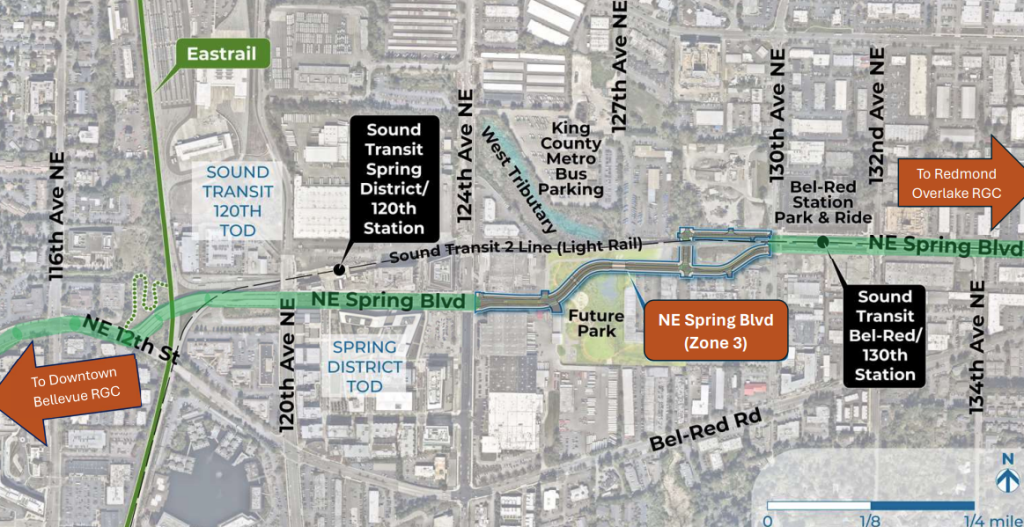
However, a fully connected Spring Boulevard is not on its way anytime soon. Construction on the new street isn’t expected to wrap up until sometime in the 2030s, and Bellevue doesn’t even expect to reach full design by the end of 2030. And the price tag is significant — $72.3 million, including an estimated $30 million to acquire property to site the new road. Even if this grant request is approved, finding the full amount for construction funding and right-of-way acquisition will still be a significant lift. Unlike the previous phases of Spring Boulevard, this project isn’t included on the list of projects set to see funding via transportation impact fees, though that could change in the future.
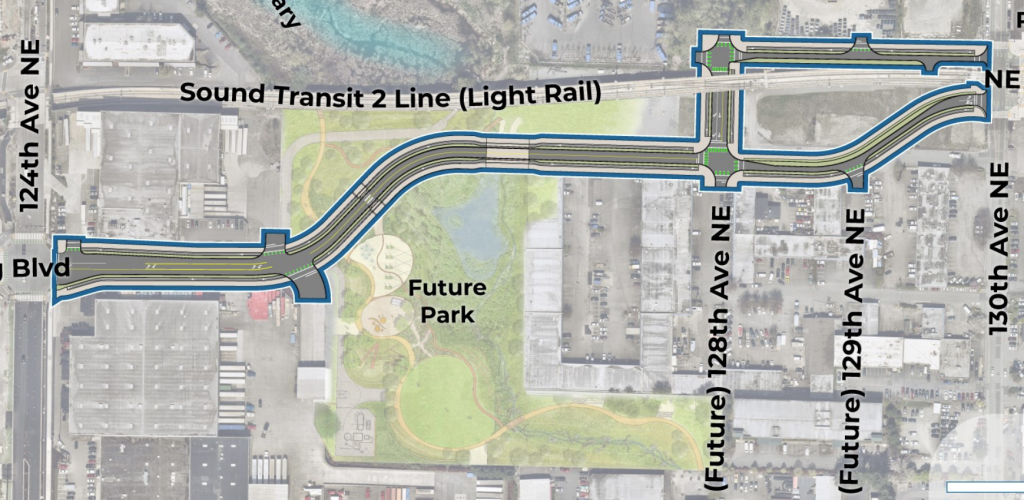
Compare that price tag to the $3.38 million estimate to add protected bike lanes to a stretch of NE 12th Street and Bel-Red Road that’s over twice as long as the planned connection along Spring Boulevard. A similar length project on Northup Way was expected to cost $3.9 million. But Spring Boulevard has been pointed to by many Bike Bellevue opponents as a reasonable alternative to making space (and improving safety) on five-lane Bel-Red Road or Northup Way.
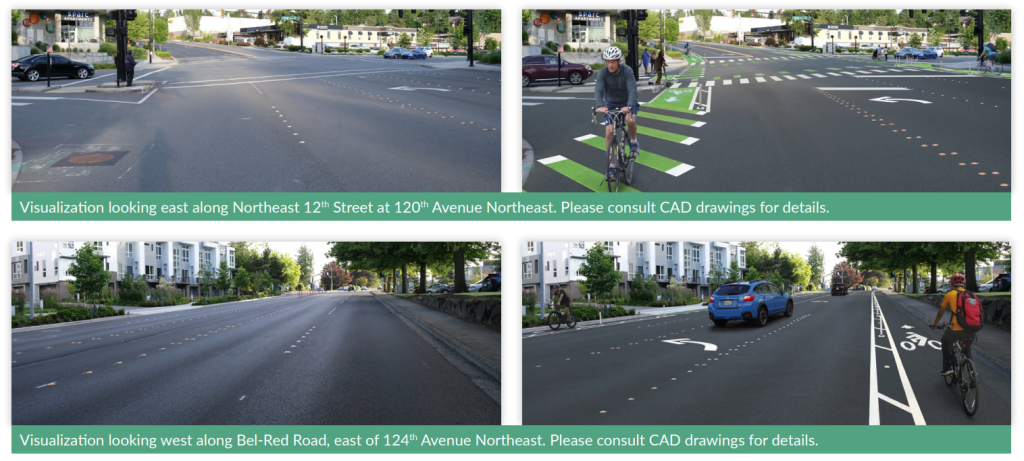
“Bellevue’s bicycle network can be greatly improved without taking any driving lanes away from our community,” a form letter created by the group Livable Bellevue and sent to city councilmembers in March read. “For example, the City could complete Spring Boulevard instead of removing arterial road lanes on Northup Way and Bel-Red Road.” An alternative network map created by Bellevue real-estate interests including Kemper Development and Wallace Properties included Spring Boulevard, arguing taking space on arterial streets would “crippl[e] the arterial road network Bellevue needs to address the traffic of today and the housing and jobs of tomorrow.”
Bellevue’s growth strategy is undeniably going to need a strong multimodal component to deal with the realities that come from geometry. Under Bellevue’s preferred growth alternative, the BelRed neighborhood, currently home to fewer than 4% of the city’s housing units, would see an increase in housing capacity of more than six times that. Under the plan, BelRed is projected to become home to 21% of the city’s capacity for new units — just under 17,000 additional units. It would also see a 10-point increase in its capacity for jobs, from 5.7% of the city’s jobs to 15.7%. Setting aside the fact that a full Spring Boulevard connection won’t be completed for close to a decade, having one safe corridor for people to be able to get around by bike in the area likely isn’t a sustainable way to build out Bellevue’s transportation system.
In its application, the City of Bellevue highlights the location of the future Spring Boulevard is smack dab in the middle of the city’s high-injury network, with east-west running BelRed Road and Northup Way, both proposed Bike Bellevue corridors, standing out in red on the map. A Spring Boulevard project doesn’t actually alleviate the need to make safety improvements along those streets, in a city that has been pursuing a Vision Zero approach aiming to eliminate traffic deaths since 2015. According to city data, three people were killed or seriously injured on Northup Way and 4 on Bel-Red Road in this area between 2011 and 2022.
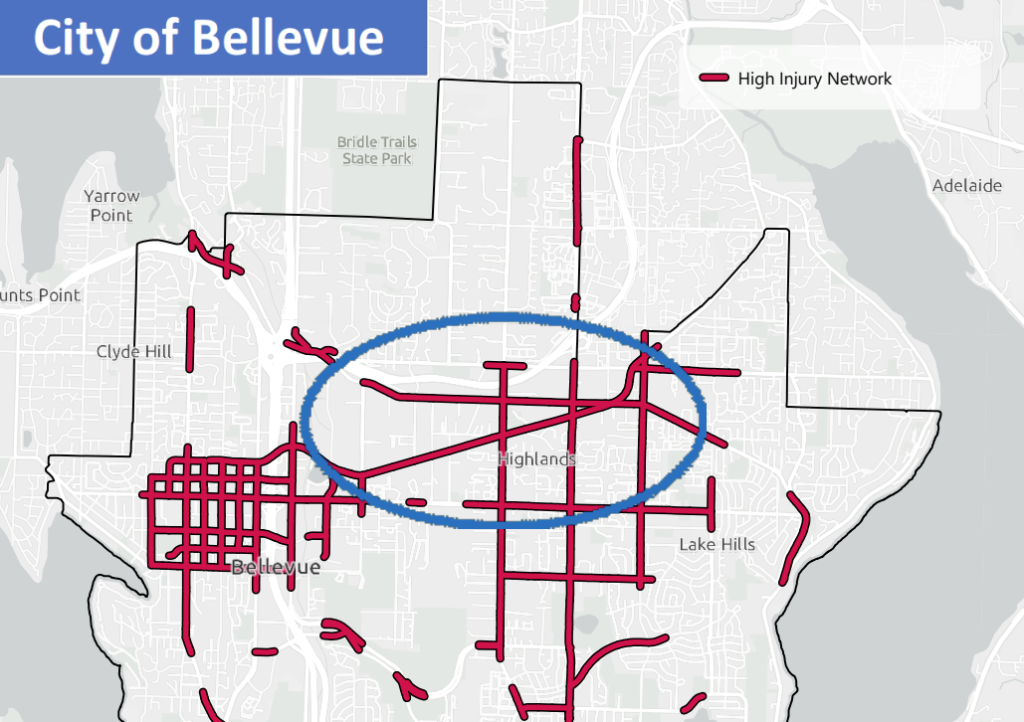
The city also highlighted the distances that people on bikes would save with the creation of Spring Boulevard, noting that a trip on Bel-Red adds an additional 0.82 miles and a trip on Northup Way adds 1.06 miles for some trips. What that ignores is the fact that people on bikes will continue to need to access businesses and services along those streets — Spring Boulevard is a clear complement and not a supplement for all kinds of different trips in the area.
While Spring Boulevard moves forward, there’s still plenty of time for Bellevue to reverse course and implement the full Bike Bellevue network, making progress on both safety and mobility at the same time. In a city with growth plans as ambitious as Bellevue, the case just isn’t there for an either/or.
Ryan Packer has been writing for The Urbanist since 2015, and currently reports full-time as Contributing Editor. Their beats are transportation, land use, public space, traffic safety, and obscure community meetings. Packer has also reported for other regional outlets including Capitol Hill Seattle, BikePortland, Seattle Met, and PubliCola. They live in the Capitol Hill neighborhood of Seattle.


